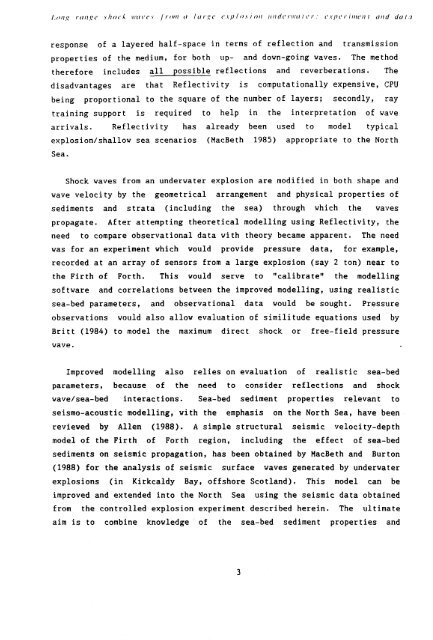Download (6Mb) - NERC Open Research Archive
Download (6Mb) - NERC Open Research Archive
Download (6Mb) - NERC Open Research Archive
Create successful ePaper yourself
Turn your PDF publications into a flip-book with our unique Google optimized e-Paper software.
I,on.!: rC/ngc s/roc/.. II'(/\'CS /rol/1 (/ largc cxplo.liol7 /lndcrwatcr: cx/Jt'rill/cnt and data<br />
response oE a layered halE-space in terms oE reElection and transmission<br />
properties oE the medium, for both up- and down-going waves. The method<br />
therefore includes all possible reflections and reverberations. The<br />
disadvantages are that Reflectivity is computationally expensive, CPU<br />
being proportional to the square of the number of layers; secondly, ray<br />
training support is required to help in the interpretation of wave<br />
arrivals. Reflectivity has already been used to model typical<br />
explosion/shallow sea scenarios (MacBeth 1985) appropriate to the North<br />
Sea.<br />
Shock waves from an underwater explosion are modified in both shape and<br />
wave velocity by the geometrical arrangement<br />
sediments and strata (including the sea)<br />
and physical properties of<br />
through which the waves<br />
propagate. After attempting theoretical modelling using Reflectivity, the<br />
need to compare observational data with theory became apparent. The need<br />
was for an experiment which would provide pressure data, for example,<br />
recorded at an array of sensors from a large explosion (say 2 ton) near to<br />
the Firth of Forth. This would serve to "calibrate" the modelling<br />
software and correlations between the improved modelling, using realistic<br />
sea-bed parameters, and observational data would be sought. Pressure<br />
observations would also allow evaluation of similitude equations used by<br />
Britt (1984) to model the maximum direct shock or free-field pressure<br />
wave.<br />
Improved modelling also relies on evaluation of realistic sea-bed<br />
parameters, because of the need to consider re flee t ions and shock<br />
wave/sea-bed interactions. Sea-bed sediment properties relevant to<br />
seismo-acoustic modelling, with the emphasis on the North Sea, have been<br />
reviewed by Allen (1988) . A simple structural seismic velocity-depth<br />
model of the Firth of Forth region, including the effect of sea-bed<br />
sediments on seismic propagation, has been obtained by MacBeth and Burton<br />
(1988) for the analysis of seismic surface waves generated by underwater<br />
explosions (in Kirkcaldy Bay, offshore Scotland). This model can be<br />
improved and extended into the North Sea using the seismic data obtained<br />
from the controlled explosion experiment described herein. The ultimate<br />
aim is to combine knowledge of the sea-bed sediment properties and<br />
3
















